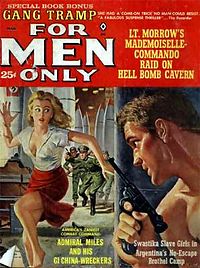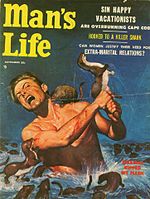- Men's adventure
-
Men's adventure is a genre of magazines that had its heyday in the 1950s and 1960s. Catering to a male audience, these magazines featured glamour photography and lurid tales of adventure that typically featured wartime feats of daring, exotic travel or conflict with wild animals.
These magazines are generally considered the last of the true pulp magazines. They reached their circulation peaks long after the genre-fiction pulps had begun to fade. These magazines were also colloquially called "armpit slicks", "men's sweat magazines" or "the sweats", especially by people in the magazine publishing or distribution trades.
Contents
Contents
Notable men's adventure magazines included Argosy, the longest-running and best regarded of the genre, as well as Adventure, Real, True, Saga, Stag, Swank and For Men Only. During their peak in the late 1950s, approximately 130 men's adventure magazines were being published simultaneously.
The interior tales usually claimed to be true stories. Women in distress were commonly featured in the painted covers or interior art, often being menaced or tortured by Nazis or, in later years, Communists. Artist Norman Saunders was the dean of illustrators for these magazines, occupying a position similar to that enjoyed by Margaret Brundage for the classic pulps. Many illustrations that were uncredited were done by Bruce Minney,[1] Norm Eastman, Gil Cohen, Mel Crair, Basil Gogos, and Vic Prezio among others.[2] Historical artist Mort Künstler painted many covers and illustrations for these magazines, and Playboy photographer Mario Casilli started out shooting pinups for this market. At publisher Martin Goodman's Magazine Management Company, future best-selling humorist and author Bruce Jay Friedman was a men's sweat writer-editor, and Mario Puzo was a contributor before he became a well-known novelist.
Many of the stories were actual historical accounts of battles and the biographies and exploits of highly decorated soldiers. Several of the stories were combined and issued under various titles in paperback editions by Pyramid Books with the credit "edited by Phil Hirsch". Phil Hirsch was vice president of Pyramid Books from 1955-1975.[3]
Legacy
The title of the Frank Zappa and the Mothers of Invention album Weasels Ripped My Flesh was borrowed from a man-against-beast cover story in the September 1956 issue of Man's Life, and the title went through another permutation when filmmaker Nathan Schiff made the horror feature Weasels Rip My Flesh (1979).
These magazines' circulation dropped precipitously in the mid-1960s. Their tales of wartime adventure appealed to American men of the World War II and Korean War generations, and these established readers were reaching an age at which these magazines' girlie pictures were less of a draw. For those who wanted pornography, more explicit and less old-fashioned publications were available by this period. The Vietnam War and its attendant social controversies did nothing to create an appetite for similar entertainments that would have involved rescuing damsels from the Viet Cong. The magazine vision of adventurous, fighting masculinity also became unfashionable. Some publications, such as Swank, survived by turning into explicitly pornographic magazines; others simply ceased publication.
There have been attempts to revive the Argosy title, once in the 1990s, and again in 2004. Soldier of Fortune seems to have carried on the tradition of true war stories for a male audience. A few contemporary "lad mag" periodicals such as FHM and Maxim are somewhat similar to the earlier adventure magazines, featuring a combination of cheesecake pictorials and occasional true adventure/horror stories.
References
- ^ http://www.menspulpmags.com/2011/05/mens-sweat-magazine-cover-paintings.html
- ^ Parfrey, Adam, et al. It's a Man's World: Men's Adventure Magazines, the Postwar Pulps (Feral House, 2003) ISBN 0-922915-81-4
- ^ http://newsgroups.derkeiler.com/Archive/Rec/rec.arts.books.childrens/2006-08/msg00087.html
External Links
Categories:- Men's magazines
- Literary genres
Wikimedia Foundation. 2010.


